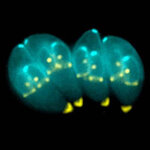Microbiology
For the first time, scientists have described the transition of the flat, disc-shaped heart field into the primary linear heart tube. The investigations on zebrafish embryos were made by Stefan Rohr and Cécile Otten, members of the research group of Dr. Salim Abdelilah-Seyfried of the Max Delbrück Center for Molecular Medicine (MDC) Berlin-Buch, Germany.
Currently, one of the most important areas to explore in developmental biology is how cellular transformation processes lead to the three-dimensional formation (morphogenesis) of organs. A better understanding of these processes is a basic…

Researchers have uncovered the mechanism that contributes to the buildup of fibrous lung tissue in patients with severe acute respiratory syndrome (SARS), finding that a SARS viral protein important for replication can enhance pulmonary fibrosis by inhibiting the activity of the enzyme that breaks down connective tissue. The results offer up a new pathway to treat the pulmonary damage of SARS.
Infection with the SARS virus can lead to severe inflammation in the lungs, which can lead to respiratory distress, fibrosis, and eventually lung failure. Ye-Guang Chen and colleagues tested the effect…

Genetic mutations in the Toll-like receptor 4 (TLR4) gene appear to have significant association with inflammatory injury to the placenta and developing baby according to researchers from the University of Pittsburgh’s department of obstetrics, gynecology and reproductive sciences.
“This indicates a possible genetic predisposition to a kind of misfire in immune system response that could contribute to placental inflammation and spontaneous preterm birth,” said Hyagriv Simhan, M.D., assistant professor of obstetrics, gynecology and reproductive sciences at the University of Pittsburgh…

In the US, most deaths are attributable to chronic afflictions, such as heart disease and cancer. Typically the medical community has attributed these diseases to accumulated damage, such as plaque formation in arteries or mutations in genes controlling cellular replication.
This view is changing.
Scientists are now beginning to recognize that many of these chronic illnesses are due to microbial infections. A recent report in the American Journal of Psychiatry suggests that schizophrenia, a mental illness leading to errors in perception, is associated with the pathogen, Toxoplasma gondii…

Boosted by physical and mental exercise, neural stem cells continue to sprout new neurons throughout life, but the exact function of these newcomers has been the topic of much debate. Removing a genetic master switch that maintains neural stem cells in their proliferative state finally gave researchers at the Salk Institute for Biological Studies some definitive answers.
Without adult neurogenesis — literally the “birth of neurons” —genetically engineered mice turned into “slow learners” that had trouble navigating a water maze and remembering the location of a submerged platform, the Salk…

Using mice as models, researchers at the Max Planck Institute for Evolutionary Anthropology traced some of the differences between humans and chimpanzees to differences in our diet.
Humans consume a distinct diet compared to other apes. Not only do we consume much more meat and fat, but we also cook our food. It has been hypothesized that adopting these dietary patterns played a key role during human evolution. However, to date, the influence of diet on the physiological and genetic differences between humans and other apes has not been widely examined.
By feeding laboratory mice different…

According to two studies published in Cell Transplantation, stroke victims may benefit from human mesenchymal stem cell (hMSC) or bone marrow stromal cell (BMSCs) transplantation. In both studies, the migration of chemically “tagged” transplanted stem cells were tracked to determine the degree to which the transplanted cells reached damaged areas of the brain and became therapeutically active.
“Both studies lend important support to a growing body of laboratory evidence that bone marrow is a remarkable adult stem cell source for transplant therapy following stroke,” says Cell Transplantation…

Once considered rare, mitochondrial diseases are now thought to affect as many as one person in 5,000. New research in this area hopes to open up more opportunities for predicting a child's risk of developing a mitochondrial disease which can cause muscle weakness, diabetes, strokes, heart failure and epilepsy.
All human and animal cells contain many mitochondria, which are involved in energy production within the body. Mitochondria have their own genetic information, known as mitochondrial DNA, or mtDNA, which is inherited. A child only inherits one copy of DNA from each parent but may…

Scientists have discovered that mice genetically engineered to lack the VGLUT3 protein in the brain have profound deafness and seizures. The finding suggests a pathway for exploring the hereditary causes of deafness and epilepsy in humans.
More broadly, the discovery provides an entry point for gaining new insight into the role of glutamate, the chemical messenger carried by the protein, says the team, led by scientists at the University of California, San Francisco. Glutamate is involved in virtually every brain function, including sensory perception, learning and memory.
The missing protein…

Traditional gene therapy has focused on supplying a normal copy of a faulty gene. RNAi turns off a problematic gene. These contrasting approaches share some of the same techniques and challenges, including delivery of a therapeutic gene or siRNA into cells. RNA interference (RNAi) represents an innovative new strategy for using small RNA molecules to silence specific genes associated with disease processes.
At least six clinical trials using RNA interference (RNAi) have been approved, “with many more coming down the pipeline,” according to the Editorial by Mark A. Kay, MD, PhD, an…